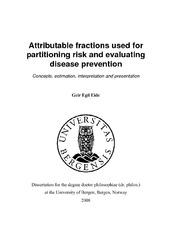| dc.contributor.author | Eide, Geir Egil | en_US |
| dc.date.accessioned | 2009-02-23T09:54:37Z | |
| dc.date.available | 2009-02-23T09:54:37Z | |
| dc.date.issued | 2008-04-18 | eng |
| dc.identifier.isbn | 978-82-308-0510-7 (print version) | en_US |
| dc.identifier.uri | https://hdl.handle.net/1956/3157 | |
| dc.description.abstract | Background: In medical research some fundamental tasks are to study potential harmful exposures that may give increased risk of getting some disease, potential beneficial treatments that may increase chance of recovering from a disease, or interventions that may reduce the extent or effect of a harmful exposure. In epidemiologic research these questions are studied by collecting individual data for representative samples of the population. For a specified disease (e.g. breast cancer) there will usually be many risk factors, some may be modifiable (e.g. life style factors like smoking habits, physical activity, dietary factors) and other factors not so easy to modify (like reproductive factors, aging, genetic factors). Provided that enough data for the individuals in the sample is collected on the occurrence of disease and the relevant risk factors, statistical models are identified to estimate the effects of the various risk factors on the prevalence or incidence of the disease in the population. Estimating the factual situation in the population and quantifying the uncertainty in the estimates are thus important aims of such statistical analyses. Having done so, a natural next question of importance is what kind of exposures can be avoided, or how many diseased cases can be prevented, if such exposure could be completely or partially eliminated. A statistical concept that can be used to quantify this is the attributable fraction. For a single disease caused by a single exposure the attributable fraction due to this factor is the proportion of diseased subjects that could have been prevented if the specified exposure had not been present. Or, in other words, one questions what would the proportionate reduction in diseased subjects in the population be if the exposure distribution had been different from what it actual is? For illustration, an Italian study estimated that 15.0 % of the breast cancer cases might have been avoided if the betacarotene intake had been increased to at least 3366 μg/day for everyone while not changing the distribution of a number of other risk factors (low vitamin E intake, residence, alcohol habits, physical activity, age, educational level, calorie intake and menopausal status). Increasing also vitamin E intake (to at least 8.5 mg /day) for all subjects gave a combined attributable fraction per cent of 21.5%. Sometimes eliminating a common exposure with a moderate increased risk of disease may have the same effect in the population at large as eliminating a rare exposure with a highly increased risk of disease. Thus, an attributable fraction depends both on the risk of disease if exposed and the extent of the exposure in the population studied. In general, the attributable fraction quantifies the proportion of cases prevented if the factual exposure distribution were replaced with a hypothetical, so called counterfactual, exposure distribution. The attributable fraction can also be crudely defined as excess proportion of diseased in the population relative to the total proportion. The attributable fraction has also several other applications, e.g. to quantify the proportion of diseased that can be ascribed to one or more exposures (epidemiology), to predict the effect of planned preventive interventions (health policy) and to apportion the responsibility for the disease to various agents responsible for the exposure (liability law). It has been used in regional and national research, as well as in global studies like the Global Burden of Disease and Comparative Risk Assessment projects of the World Health Organization. Results: With multiple risk factors attributable fractions can be defined in many ways depending on how the counterfactual situation is hypothesized. This thesis describes how attributable fractions can be defined, interpreted and estimated for various scenarios, e.g. one factor is eliminated while the rest is kept fixed; several factors are eliminated; and, multiple factors are removed sequentially may be in different orderings. It also describes convenient graphical methods to illustrate the potential impact on disease load in a population from interventions on one or more risk factors. The statistical and graphical methodology is potentially useful as tools in health policy discussions illustrating possible effects of different preventive strategies under evaluation and may ease the communication between researchers, decision takers and the public. Which strategy will have the largest effect in a public health perspective? Which factors should be given priority in a public health intervention or in legislation? How much can be achieved by changing personal habits versus general prevention of environmental exposure locally, nationally or globally? Methodology for computerized, and possibly interactive, manipulations of different scenarios is developed to depict the estimates of possible consequences. The statistical methodology for attributable fractions has traditionally been developed in relation to the classical epidemiological research designs like case-control studies, cross-sectional studies and cohort studies with fixed time to follow-up. Based on the statistical models for analysing time-to-event data the thesis extends and reformulates the traditional definitions of attributable fraction so as to apply also for scenarios where the risk of disease in the population is developing through time and actions against harmful exposure or treatment or other intervention may be implemented at different time points. Thus immediate, later, as well as cumulative effects of an intervention on the disease load in the population are incorporated in these new attributable fraction concepts. Conclusions: In summary, the thesis discusses many types of attributable fractions to be used for various purposes. The thesis provides methodology for making adequate choices for the question at hand. It also gives new algorithms for calculating attributable fractions extending those of standard statistical software, and it suggests graphical displays that are useful for communicating research results concerning attributable fractions, most of which are not found in standard statistical software of today. Finally, new methodology for dynamic modelling of attributable fractions taking time to disease, time of intervention, or other time-dynamic aspects, into account is suggested by relating the methodology of attributable fractions to established theory of survival analysis. The latter will be an interesting field for further methodological research as will also relating the concepts of attributable fraction to the recent development in causal statistical modelling. | en_US |
| dc.language.iso | eng | eng |
| dc.publisher | The University of Bergen | eng |
| dc.relation.haspart | Paper I: Journal of Clinical Epidemiology 48, Eide, Geir Egil & Gefeller, Olaf, Sequential and average attributable fractions as aids in the selection of preventive strategies, pp. 645-655. Copyright 1995 Elsevier. Abstract only. Full-text not available due to publisher restrictions. | en_US |
| dc.relation.haspart | Paper II: Statistical Methods in Medical Research 10(3), Eide, Geir Egil & Heuch, Ivar, Attributable fractions: fundamental concepts and their visualization, pp. 159-193. Copyright 2001 Arnold. Published by Sage Publications. Abstract only. Full-text not available due to publisher restrictions. | en_US |
| dc.relation.haspart | Paper III. Biometrical Journal 48(1), Eide, Geir Egil & Heuch, Ivar, A scaled sample space cube used to illustrate attributable fractions, pp. 93-104. Copyright 2006 WILEY-VCH Verlag GmbH & Co. KGaA, Weinheim. <a href="http://dx.doi.org/10.1002/bimj.200410156" target="blank">http://dx.doi.org/10.1002/bimj.200410156</a> Abstract only. Full-text not available due to publisher restrictions. | en_US |
| dc.relation.haspart | Paper IV. Biometrical Journal 48(5), Eide, Geir Egil & Heuch, Ivar, Average attributable fractions: a coherent theory for apportioning excess risk to individual risk factors and subpopulations, pp. 820-837. Copyright 2006 WILEY-VCH Verlag GmbH & Co. KGaA, Weinheim. <a href="http://dx.doi.org/10.1002/bimj.200410156" target="blank">http://dx.doi.org/10.1002/bimj.200410156</a> Abstract only. Full-text not available due to publisher restrictions. | en_US |
| dc.relation.haspart | Paper V. Statistics in Medicine 27(9), Samuelsen, Sven Ove & Eide, Geir Egil, Attributable fractions with survival data, pp. 1447 – 1467. Copyright 2008 John Wiley & Sons, Ltd. <a href="http://dx.doi.org/10.1002/sim.3022" target="blank">http://dx.doi.org/10.1002/sim.3022</a> Abstract only. Full-text not available due to publisher restrictions. | en_US |
| dc.title | Attributable fractions used for partitioning risk and evaluating disease prevention. Concepts, estimation, interpretation and presentation | en_US |
| dc.type | Doctoral thesis | |
| dc.subject.nsi | VDP::Medisinske Fag: 700::Helsefag: 800::Epidemiologi medisinsk og odontologisk statistikk: 803 | nob |





